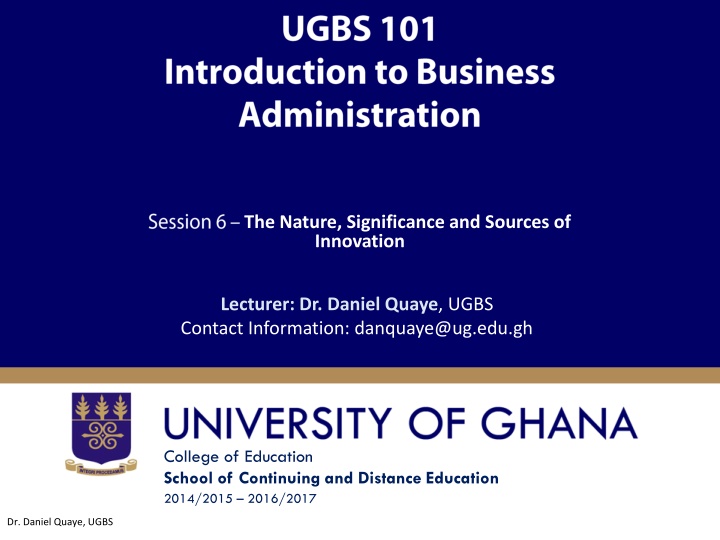
Unveiling the Essence of Innovation - Dr. Daniel Quaye UGBS Insights
Delve into the world of innovation with Dr. Daniel Quaye from UGBS as he enlightens on the nature, significance, and sources of innovation. Discover how innovation extends beyond technology to encompass social aspects and clears misconceptions regarding invention, products, and originality.
Download Presentation

Please find below an Image/Link to download the presentation.
The content on the website is provided AS IS for your information and personal use only. It may not be sold, licensed, or shared on other websites without obtaining consent from the author. If you encounter any issues during the download, it is possible that the publisher has removed the file from their server.
You are allowed to download the files provided on this website for personal or commercial use, subject to the condition that they are used lawfully. All files are the property of their respective owners.
The content on the website is provided AS IS for your information and personal use only. It may not be sold, licensed, or shared on other websites without obtaining consent from the author.
E N D
Presentation Transcript
The Nature, Significance and Sources of Innovation Lecturer: Dr. Daniel Quaye, UGBS Contact Information: danquaye@ug.edu.gh College of Education School of Continuing and Distance Education 2014/2015 2016/2017 Dr. Daniel Quaye, UGBS
What is Innovation? Drucker (1986) defines innovation as the specific instrument of entrepreneurship. It is the act that endows resources with a new capacity to create wealth . La Salle (2002) Change that adds value the key to success in product creation. Australian Institute of Management (2001) Something new or significantly different in a business that creates value directly to the business or indirectly through its customers. Slide 2 Dr. Daniel Quaye, UGBS
When you think of innovation what comes to mind? Science or Technology? Actually innovation is not necessarily based on science or technology. Innovation can be social. Social innovation such as schools, universities, banks, hospitals and public service are far more difficult to achieve than building cars and trains. Slide 3 Dr. Daniel Quaye, UGBS
2. Misconceptions of Innovation a. Innovation is invention Although innovation is linked to invention, they are not necessarily the same. An invention is a creative idea, while innovation takes that idea, and puts it to work. Slide 4 Dr. Daniel Quaye, UGBS
CONT. MISCONCEPTIONS... b. Innovation represents new products and services only: Innovation may result in new products or services, however, it is not solely confined to their development. It embraces new developments in other fields including; Slide 5 Dr. Daniel Quaye, UGBS
Cont. Misconceptions... (i) New Markets: It is innovative to take existing products or services and sell them into new markets. (ii) New Marketing methods: The product or service can remain the same and the market does not change; the key to innovation may then come from the marketing of the product to the customer. Slide 6 Dr. Daniel Quaye, UGBS
Cont. Misconceptions... c) Innovation has to be original Innovation does not take place in a vacuum. New ideas always have roots in the old; they start with what already exist, and become original from the unique way in which they combined or connected to existing ideas and knowledge. Dr. Daniel Quaye, UGBS
Sources of Innovation a) The unexpected A common indicator of underlying change is the unexpected result, either success or failure. Unexpected success, or failure, often gives clues to underlying trends which can lead to innovation. (i) Unexpected Success ii) Unexpected failure Slide 8 Dr. Daniel Quaye, UGBS
Cont. sources b. Process need The importance of need as a source of innovation is captured in the proverb: Necessity is the mother of invention . Slide 9 Dr. Daniel Quaye, UGBS
Cont. sources c) Industry and market structures Industry and market structures can change rapidly, sometimes after a long period of stability. Such changes offer exceptional opportunities to innovations. d) Demographics Changes to the environment of an enterprise inevitably contain many possibilities for innovation, but are often hard to see, or understand, until they are past and the opportunities missed. Demographic changes, however, are clear and unambiguous, and signalled well in advance. Slide 10 Dr. Daniel Quaye, UGBS
Cont. sources e) Changes in perception The facts may not change, however, peoples perception of the facts change, which has an equally powerful effect. f) New knowledge The most famous innovations are often based on new knowledge. Slide 11 Dr. Daniel Quaye, UGBS
Characteristics of imaginative people i. Self-motivated ii. Have expertise in chosen field. iii. Are risk takers. iv. Possess social skills. Slide 12 Dr. Daniel Quaye, UGBS
Reading list Introduction of Business Administration Distance Education Manual- Dr Daniel Quaye. Madura, Jeff (2007), Introduction to Business Administration, South-Western College Slide 13 Dr. Richard Boateng, UGBS
